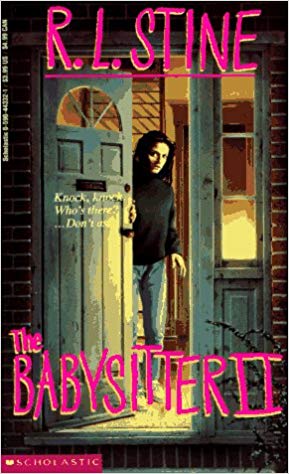 Title: The Baby-Sitter II
Title: The Baby-Sitter II
Author: R.L. Stine
Published: 1991
Publisher: Scholastic
—
The Baby-Sitter II is a much different book in tone than the original, but, at the same time, follows a familiar path when it comes to the story beats. My biggest surprise throughout was the realization that, contrary to my belief, I had not read this story when I was younger. Sure, I may have skimmed the first chapter or two, but nothing felt familiar at all, and I am certain I was reading this in whole for the first time. Unfortunately for the book, that means the only nostalgic thing about it for me is the cover, which, to be fair, is pretty great (pictured to the left).
This first sequel picks up one summer after Jenny suffered the tragic events of the original. Now a survivor, Jenny is suffering from a great deal of post-traumatic stress disorder, and seeing a therapist to help talk through her mental health issues. Frankly, I was impressed that this was introduced given when this book was released. We are much more accepting and understanding of mental health issues today as a society, than in the early 1990s. So though this theme would be common for a young adult book now, I feel like it was likely more rare back then.
Jenny’s mental health is really the driving factor of the entire novel. Though she always had an overactive imagination in the first novel, and thought that most people were out to get her, it was nothing compared to the Jenny in this sequel. She doesn’t even look to see who might be behind her in one of the opening chapters, she just hears footsteps that start to get quicker, and immediately starts panicking, running down the streets for fear of being attacked. This is the start to the idea that Jenny has that everyone is out to get her, and that doesn’t falter throughout.
Jenny has decided to take another babysitting job this summer because, again, she and her mother need the money. Though her two new friends are working at a shoe store in the mall, she thinks this babysitting job will help her cope with her anxiety and move on from her past. The boy she babysits is nothing like the sweet kid from last summer, though. This child has a genius level IQ, few friends, and prefers his computers and pet tarantulas over any board games over hide and seek. She figures she can deal with him, though, until she starts getting some phone calls late at night from a voice that is eerily familiar to the voice from last year. Jenny knows that this can’t be the same person…or can it?
The Baby-Sitter II is a much darker book, and it touches on both mental health, and physical abuse from trusted individuals. There were moments that really surprised me due to their violence, and while it wasn’t explicit by any stretch, it was still unexpected. Stine creates these moments, but he doesn’t really do much to speak to them; they just happen, and the characters move on with little to no resolution. Likely because of the age of the book, and the target audience, Stine probably didn’t feel it necessary to provide any commentary surrounding these moments. It is disappointing, but not something the book chooses to explore any further.
Though we do get deeper into Jenny’s mental state, and meet new characters, the story feels quite familiar to the original, even going so far as essentially repeating the climax of the first book in some ways. This repetition was a bit of a drag on The Baby-Sitter II, and it didn’t do much to stand itself apart in any way. Because of this, it is a book that I didn’t hate nor love, but rather feel a bit indifferent about. Sure, it’s fine, and I enjoyed myself while reading it, but it’s not one that will stick with me at all. Still, I want to see where Jenny’s story goes, and discover if there is any eventual payoff for some of the things Stine established in this outing.


Branden has been a film fan since he was young, roaming the halls of Blockbuster Video, trying to find the grossest, scariest looking VHS covers to rent and watch alone in the basement. It wasn’t until recently, though, that Branden started seeking out the classics of cinema, and began to develop his true passion for the art form. Branden approaches each film with the unique perspective of having studied the art from the inside, having both a bachelor’s and master’s degree in acting. He has been a film critic since 2010, and has previously written for Inside Pulse Movies, We Love Cult, and Diehard Gamefan. His biggest achievement as a film critic, to date, has been founding Cinefessions and turning it from a personal blog to a true film website, housing hundreds of film and television reviews, and dozens of podcasts.


